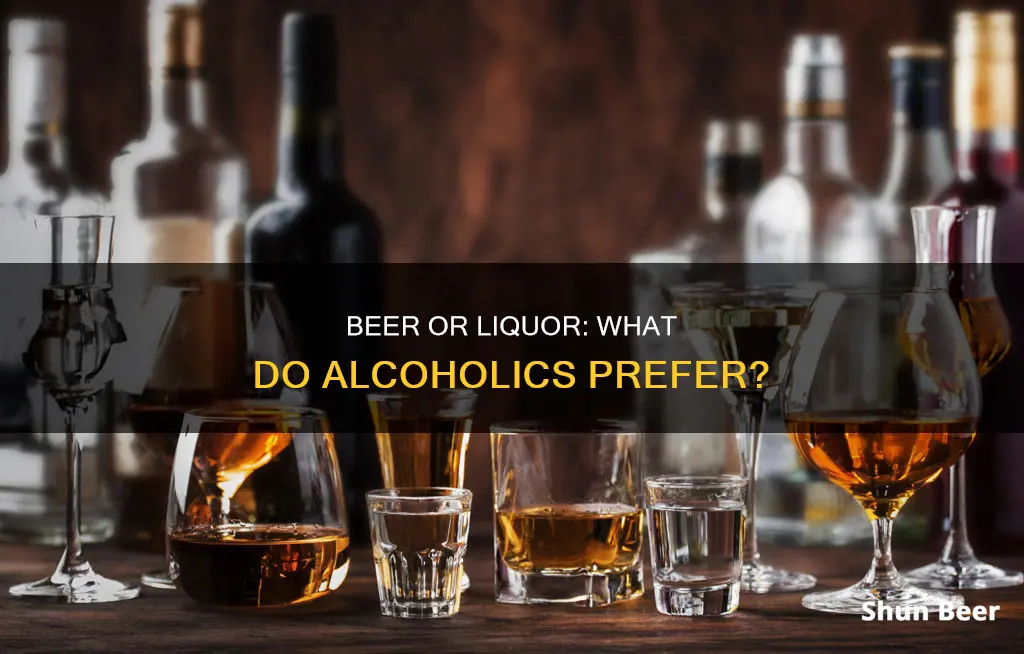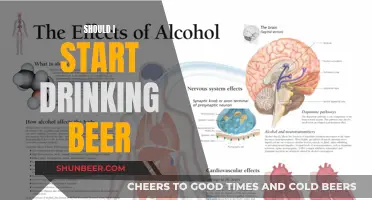
Alcoholism, or alcohol use disorder (AUD), is a chronic addiction that can develop when someone feels a craving for alcohol that they cannot get rid of. Alcoholics constantly crave alcohol and experience withdrawal symptoms when they go for hours or days without consuming it. Alcohol is a depressant that affects the central nervous system and impairs a person's judgement and behaviour. It is typically divided into three classes: beers, wines, and spirits. All alcoholic drinks have the same active ingredient, ethyl alcohol, and therefore have the same effects on the body and brain. Beer, wine, and liquor can all lead to lifelong addiction and a multitude of health consequences.
Although beer has a relatively low alcohol content and is socially acceptable, it can still trigger alcohol abuse and addiction issues. Beer is the most consumed alcoholic beverage worldwide and is likely the oldest alcoholic drink in history. A standard beer has between 4% and 6% ABV, although some beers have higher or lower concentrations. For example, light beers have between 2% and 4% ABV, while malt liquors have between 6% and 8%.
Wine is another popular and ancient alcoholic beverage. Standard wine has less than 14% ABV, although some wines can have much lower or higher ABVs. Champagne, for instance, has an alcohol concentration of about 10% to 12%, while fortified wines like sherry or port can have up to 26% ABV.
Liquor contains the highest alcohol content of the three beverages. Examples of liquor include tequila, gin, whiskey, vodka, and rum. A typical serving size of liquor is 1.5 fluid ounces, which contains about 40% alcohol. Liquor can be extremely dangerous because it is often mixed with larger drinks such as soda or juice, making it easier for individuals to consume excessive amounts of alcohol in a short period.
| Characteristics | Values |
|---|---|
| Definition of Alcoholism | Craving for alcohol that can't be controlled; feeling withdrawal symptoms without it |
| Beer as a "safe" drink | Beer is not a safe drink as it still contains alcohol and can lead to addiction |
| Misuse of alcohol | Binge drinking, heavy drinking |
| Binge drinking | 5 drinks within 2 hours for men; 4 drinks within 2 hours for women |
| Heavy alcohol use | 14 or more drinks per week for men; 7 or more drinks per week for women |
| Standard serving sizes | Beer – 12 fluid ounces; Hard Liquor – 1.5 fluid ounces; Malt Liquor – 8 to 9 fluid ounces; Wine – 5 fluid ounces; Liqueurs and Cordials – 2 to 3 fluid ounces |
| Alcohol by volume (ABV) | Beer: 4% to 6% ABV, with some beers having higher or lower concentrations; Wine: less than 14% ABV; Champagne: 10% to 12% ABV; Fortified wines: 20% ABV; Hard cider: 5% ABV; Mead: 10% to 14% ABV; Sake: 16% ABV |
| Alcohol Use Disorder (AUD) | Craving alcohol; failing to fulfill obligations due to alcohol use; continuing to drink despite social or interpersonal problems; giving up activities because of alcohol use; drinking in dangerous situations; developing tolerance; experiencing withdrawal symptoms |
What You'll Learn
- Beer, wine, and liquor are all ethanol, the only type of alcohol safe for human consumption
- Beer is the most popular alcoholic beverage worldwide
- Alcohol is a depressant that affects the central nervous system and impairs judgement and behaviour
- Binge drinking for men is five drinks within two hours, and for women, it is four drinks within two hours
- Alcoholism is a chronic, relapsing disease diagnosed based on certain criteria outlined by the DSM-5

Beer, wine, and liquor are all ethanol, the only type of alcohol safe for human consumption
Alcoholic drinks are typically divided into three classes: beer, wine, and spirits (also known as liquors or distilled drinks). These drinks are all ethanol, a type of alcohol that humans can consume without dying. Ethanol is also used in hand sanitiser, as a sterilising agent, and in surface coatings, dyes, inks, adhesives, preservatives, pesticides, explosives, and medicines.
Despite ethanol's wide range of uses, it is a toxic, psychoactive, and dependence-producing substance. The World Health Organization has published a statement in The Lancet Public Health declaring that there is no safe amount of alcohol consumption that does not affect health. Alcohol is a Group 1 carcinogen, the highest-risk group, which also includes asbestos, radiation, and tobacco. It causes at least seven types of cancer, including common types such as bowel cancer and female breast cancer. The risk of developing cancer increases substantially with the amount of alcohol consumed, but even "light" and "moderate" drinking patterns can cause alcohol-attributable cancers.
Beer is typically made from the fermentation of barley or other grains and is flavoured with hops, which act as a preserving agent and flavour booster. A typical serving is about 12 ounces and contains 5% alcohol. Wine, on the other hand, is made from fermented grapes and is often paired with specific types of food or meals at social events. The typical serving size for wine is 5 fluid ounces and contains about 12% alcohol. Liquor, or spirits, contain the highest alcohol content of the three beverages, typically about 40%. Examples include tequila, gin, whiskey, vodka, and rum. A standard serving size is 1.5 fluid ounces.
While moderate drinking in social settings can be normal, it can become a habit that leads to binge drinking and addiction. Binge drinking is defined as consuming more than 5 drinks (for men) or 4 drinks (for women) in a two-hour period. When binge drinking behaviours persist multiple times a month, they can cause a serious chemical dependence on alcohol and lead to addiction. All types of alcoholic beverages can lead to lifelong addiction and a multitude of health consequences, including an increased risk of developing several types of cancer, cardiovascular disease, physical dependence, and damage to the body's main organs and immune system.
Ibuprofen and Beer: Safe Mix or Not?
You may want to see also

Beer is the most popular alcoholic beverage worldwide
Alcohol is one of the most widely used recreational drugs in the world, with about 33% of all humans currently drinking alcohol. Beer is the most consumed alcoholic beverage in the world. Globally, beer drives the market for alcoholic beverages.
Beer is a beverage fermented from grain mash. It is typically made from barley or a blend of several grains and flavoured with hops. Most beer is naturally carbonated as part of the fermentation process. If the fermented mash is distilled, then the drink becomes a spirit.
The amount of liquid in your glass, can, or bottle does not necessarily correspond to how much alcohol is in your drink. Different types of beer, wine, or malt liquor can have very different amounts of alcohol content. For example, many light beers have almost as much alcohol as regular beer – about 85% as much. A typical serving of beer is about 12 ounces, which is usually about 5% alcohol. In comparison to wine and liquor, beer has the least amount of alcohol content with 5% in a single serving, but the serving size (12 ounces) is larger than a normal wine serving or a mixed drink, making the one-drink alcohol content roughly equivalent to wine and hard alcohol.
In 2019, the global alcohol consumption, measured in litres of pure alcohol per person of 15 years of age or older, was 5.5 litres, which was a 4.7% relative decrease from 5.7 litres in 2010. According to the 2022 National Survey on Drug Use and Health, 137.4 million people above the age of 12 reported that they had drunk in the past 30 days, including 66.4 million females in the same age group.
Alcoholism remains an epidemic in the US. The National Institute on Alcohol Abuse and Alcoholism says 16.3 million adults were diagnosed with Alcohol Use Disorder (AUD) in 2014. Excessive alcohol use causes approximately 88,000 deaths per year. The consequences of alcohol abuse can negatively impact a person's livelihood, can make it difficult to maintain daily responsibilities and meaningful relationships, and can cause premature death.
Botox and Beer: A Safe Combination?
You may want to see also

Alcohol is a depressant that affects the central nervous system and impairs judgement and behaviour
Alcohol is a central nervous system depressant, meaning it slows down brain function and neural activity. It is a drug that
Beer and Gum Grafts: What You Need to Know
You may want to see also

Binge drinking for men is five drinks within two hours, and for women, it is four drinks within two hours
Alcoholism is a disease that harms individuals emotionally, physically, and spiritually. Alcohol is a depressant that affects the central nervous system and impairs a person's judgment and behaviour. Beer, wine, and liquor can all have debilitating effects on the user.
Binge drinking is a pattern of drinking alcohol that brings the blood alcohol concentration (BAC) to 0.08% or above. This typically happens when a man consumes five or more drinks, and a woman consumes four or more drinks, within a two-hour period. Binge drinking is not unique to one age group or gender, and it is a concern among all age groups. According to the 2023 National Survey on Drug Use and Health, about 61.4 million people in the United States aged 12 and older reported binge drinking in the past month.
The consequences of binge drinking can be severe and include a higher risk of injuries, violence, unsafe sexual behaviour, and social consequences. It also increases the likelihood of falls, burns, drownings, and car crashes. Additionally, binge drinking can lead to long-term health problems such as liver and heart disease and cancer.
Moderate drinking is defined as consuming one drink per day for women and two drinks per day for men. However, when drinking socially becomes a habit, individuals may engage in binge drinking behaviours and may become addicted. Alcohol addiction can lead to a lifetime of health-related problems and increase the likelihood of premature death.
Beer and Xeralto: Safe Mix or Health Risk?
You may want to see also

Alcoholism is a chronic, relapsing disease diagnosed based on certain criteria outlined by the DSM-5
Alcoholism is a chronic, relapsing disease that can be diagnosed based on certain criteria outlined by the DSM-5. The Diagnostic and Statistical Manual of Mental Disorders, 5th Edition (DSM-5), is a publication of the American Psychiatric Association that provides mental health professionals with a standard diagnostic tool for various mental health disorders, including alcohol use disorder (AUD). AUD is the clinical term for alcohol addiction.
The DSM-5 combines the DSM-IV disorders of alcohol abuse and alcohol dependence into a single disorder: AUD. This change was made because research found that the two disorders were better understood as a single condition with a spectrum of severity. The DSM-5 also adds "craving" as a criterion for an AUD diagnosis and removes "legal problems."
The severity of AUD is classified as mild, moderate, or severe, based on the number of criteria met within a 12-month period. Mild AUD is diagnosed when 2-3 criteria are met, moderate AUD when 4-5 criteria are met, and severe AUD when 6 or more criteria are met. The criteria include symptoms such as increased alcohol tolerance, withdrawal symptoms, spending a lot of time drinking or recovering from drinking, and continued drinking despite negative consequences.
Chronic alcohol use can lead to interference with personal relationships, motor vehicle accidents, violence, crime, and suicide. It can also cause severe health issues, including memory and coordination problems, brain changes, cardiovascular issues, an increased risk of certain cancers, and a weakened immune system.
The stages of alcoholism include early, chronic, and end stages. Individuals progress from occasional binges to daily drinking and then addiction. However, not everyone who engages in binge drinking will progress to alcohol dependence or addiction. Environmental and genetic factors also play a role in increasing the risk of alcohol misuse and addiction.
Overall, the DSM-5 provides a standardized framework for diagnosing and understanding AUD, helping professionals provide appropriate treatment and care for individuals struggling with this chronic and relapsing disease.
Beer and Colon Prep: Is It Safe to Drink?
You may want to see also
Frequently asked questions
Alcoholism, or alcohol use disorder (AUD), is when someone has a craving they can't get rid of until they have another sip of alcohol and continue drinking it even when they should be stopping.
Some common signs of alcohol dependence include:
- Having an increased tolerance to alcohol.
- Your social activities begin to revolve around drinking.
- Feeling an intense urge to drink when engaged in other activities.
- Drinking in secret or drinking alone.
- Prioritising drinking over anything else in your life.
Binge drinking is consuming a large amount of alcohol in a short amount of time, which brings the blood alcohol concentration (BAC) to 0.08% or higher. For men, it is typically when they consume more than 5 drinks in two hours, and for women, it is when they consume more than 4 drinks in two hours.
Undistilled drinks are also called fermented drinks. Fermentation is the process by which bacteria or yeast chemically converts sugar into ethanol. Wine and beer are both fermented, undistilled alcoholic beverages. Liquors and spirits are distilled alcoholic beverages and contain more alcohol by volume than undistilled drinks.
A standard drink contains around 14 grams (0.6 fluid ounces) of pure alcohol. In the US, this can generally be found in 12 ounces of regular beer, 5 ounces of wine, or 1.5 ounces of distilled spirits.







